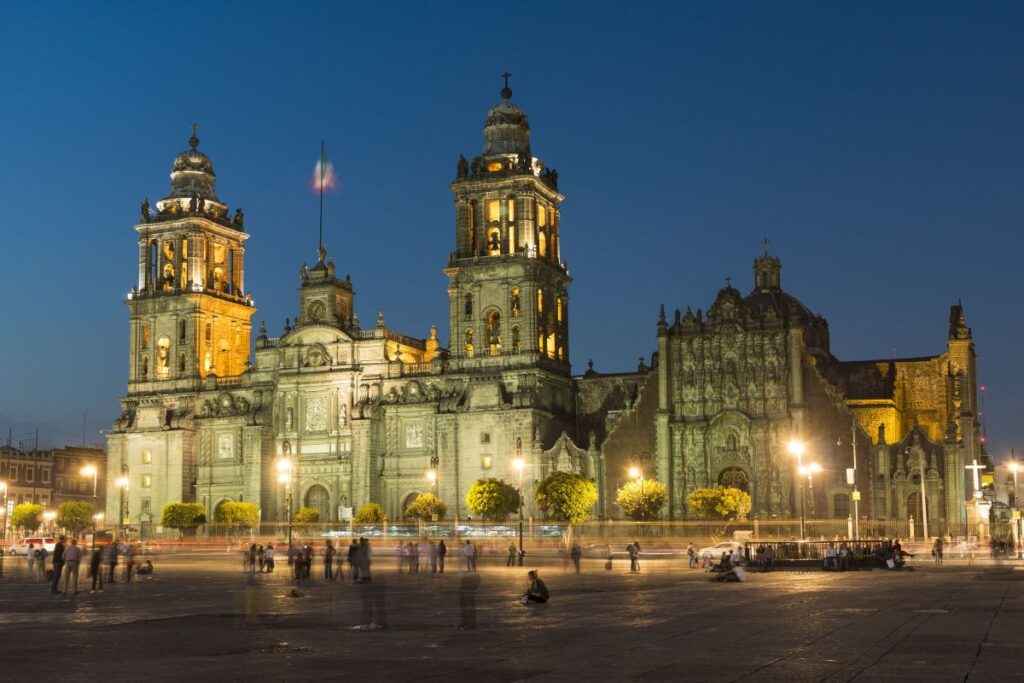Historic Center of Mexico City (or simply Historic Center) is the part of said city that gave rise and birth to its subsequent development and development, and was declared a Cultural Heritage of Humanity by Unesco since 1987. It currently comprises around 1,436 historic buildings spread over 9 km2 of surface.
The Historic Center was born before the arrival of Europeans to American lands, it is the place from where the old Tenochtitlán was built, the one that was destroyed by the Spanish, and where they rebuilt the capital of New Spain.
Since its origins, it has served as the birthplace of the four main roads of the ancient Tenochtitlán, and that even today, on the modern buildings of Mexico City, retain their layout and utility.

The four roads that were born in what is now known as the Historic Center are
- Tepeyac, bound for the North;
- Tacuba, bound for the Poniente;
- Iztapalapa, bound for the East;
- Coyoacán; bound for the South.
Due to its historical relevance throughout several eras, today you can find numerous public squares, buildings, palaces, temples, museums and markets that are reference points and have survived the passage of time.
It is the Historic Center that renames Mexico City with the nickname of The City of Palaces.
This name is given to the old quarter of the colonial and nineteenth-century city, made up of 668 blocks that house some 1,500 buildings cataloged with artistic or historical value, among religious, civil, welfare, hospital, administrative, educational, cultural and housing constructions, ranging from from the 16th century to the 20th century, and which continues to be the economic and political heart of the city, despite its current proportions, due to its importance based on its monumental wealth, since it is considered the most relevant historical center in America. It has been the object of special programs for its rehabilitation for at least 30 years, which also attend to questions of a legal nature, as well as planning and which at the same time seek to guarantee its permanence with direct intervention in construction, streets and squares.
Historical buildings
In the Historic Center of Mexico City there are real architectural gems such as the Metropolitan Cathedral of Mexico City, built over three centuries and which encompasses the different styles of the viceroyalty era in the same space. A few steps from the cathedral are the National Palace, headquarters of the Mexican Executive Power and the City Hall of Mexico City, both in front of the city’s Zócalo or Plaza de la Constitución (the second largest in the world after Red Square. Moscow).
Walking towards the Alameda Central area, on Calle de 5 de Mayo, we come across outstanding examples of Porfirian eclectic architecture. Very close to there, on Calle de Tacuba, we come across such traditional places in the city, such as El Café Tacuba, a pleasant restaurant, decorated with excellent Mexican taste with Talavera mosaics and where the delicacies of the kitchen are served. traditional Mexican. On the same street is Plaza Manuel Tolsá, a place of great architectural harmony, with such outstanding buildings as the National Museum of Art, one of the most beautiful in the Historic Center, and the Mining Palace, with an austere sobriety, neoclassical architecture that houses the Book Fair of the Palacio de Minería, one of the busiest in the city. Almost in front of Plaza Manuel Tolsá,next to the Palacio de Minería, is the beautiful Postal Palace, a refined building inspired by the architecture of Venice.
Spanish Cultural Center Right in front of the Postal Palace, crossing the Central Axis, we find the wonderful Palace of Fine Arts, one of the most beautiful concert halls in the world, decorated with impressive sculptures executed in Art Nouveau style for the exterior, which contrast with the sober elegance of its Art Deco interior, decorated with geometric and pre-Hispanic motifs. It is in front of this Palace, from where we can appreciate another of the most symbolic buildings of the city, the Latin American Tower, the first skyscraper in the city and in its time the tallest construction in Latin America, which at its peak has a viewpoint, which on clear days, allows you to have beautiful views of the four cardinal points of the city.
